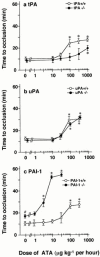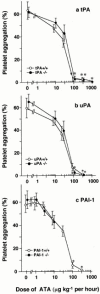The interaction between components of the fibrinolytic system and GPIb/V/IX of platelets thrombus formation in mice
- PMID: 11030738
- PMCID: PMC1572395
- DOI: 10.1038/sj.bjp.0703639
The interaction between components of the fibrinolytic system and GPIb/V/IX of platelets thrombus formation in mice
Abstract
The interaction of fibrinolytic components with GPIb/V/IX of platelets on thrombus formation, was investigated in mice deficient in tissue type (tPA-/-), urokinase type plasminogen activator (uPA-/-) or plasminogen activator inhibitor-1 (PAI-1-/-) and in their wild type control (tPA+/+, uPA+/+, PAI-1+/+). A thrombus was induced in the murine carotid artery using a photochemical reaction. The times to occlusion after the initiation of endothelial injury in all wild type mice was within 12 min, and no significant changes in occlusion delay were observed in uPA-/- and tPA-/- mice compared to wild type mice, whereas that of PAI-1 mice were significantly prolonged (16.9+/-2.9 min, P<0.05). When high molecular weight aurintricarboxylic acid (ATA), an inhibitor of platelet glycoprotein Ib/V/IX, was administered, the time to occlusion was prolonged in a dose-dependent manner in all types of mice. However, when this compound was injected in tPA-/- mice, the most significant changes were observed: i.e. the estimated ED(50) was 20.2 times higher than that in tPA+/+ mice, but the estimated ED(50) in uPA-/- mice was not changed as compared with that of wild type mice. On the other hand, when ATA was injected in PAI-1-/- mice, the estimated ED(50) was significantly decreased (P<0.05). Platelet aggregation induced by botrocetin was not significantly different among all types of mice. The bleeding time was prolonged in a dose dependent-manner when ATA was injected in all types of mice. In conclusion, the antithrombotic effect of inhibition of platelet GPIb/V/IX is severely affected by the absence or presence of tPA-production on thrombus formation and the inhibition of PAI-1 could enhance this antithrombotic effect.
Figures



References
-
- BIEMOND B.J., LEVI M., CORONEL R., JANSE M.J., CATE J.W., PANNEKOEK H. Thrombolysis and reocclusion in experimental jugular vein and coronary artery thrombosis. Effects of a plasminogen activator inhibitor type 1-neutralizing monoclonal antibody. Circulation. 1995;91:1175–1181. - PubMed
-
- BRAATEN J.V., HANDT S., JEROME W.G., KIRKPATRICK J., LEWIS J.C., HANTGAN R.R. Regulation of fibrinolysis by platelet-released plasminogen activator inhibitor 1: light scattering and ultrastructural examination of lysis of a model platelet-fibrin thrombus. Blood. 1993;81:1290–1299. - PubMed
-
- CARMELIET P., SCHOONJANS L., KIECKENS L., REAM B., DEGEN J., BRONSON R., DE VOS R., VAN DEN OORD J.J., COLLEN D., MULLIGAN R.C. Physiological consequence of loss of plasminogen activator gene function in mice. Nature. 1994;368:419–424. - PubMed
MeSH terms
Substances
LinkOut - more resources
Full Text Sources
Medical
Research Materials
Miscellaneous

